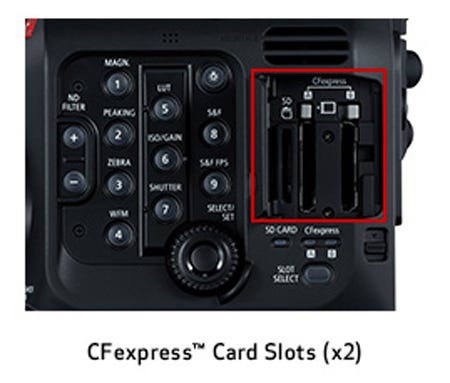





more
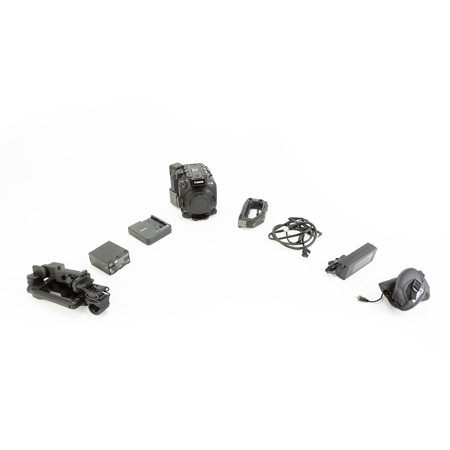
Need help? Ask our experts.
Review Summary
2021-06-21T21:40:03
Great camera but Adorama please check the specs you wrote
Stephen A.
2021-01-17T06:49:05
C700 DONE RIGHT !
AUDIO I.
2020-09-11T11:47:09
one word. unbelievable. colour, latitude, super impressed.
simon g.
2020-04-21T12:07:02
This camera is a BEAST. Build quality is what Canon is known for and this does not disappoint. The images are crisp because of the 5.9k sensor and the dual pixel autofocus is super reliable. It pairs with my C200 perfectly and plays well with all my EF lenses. I just wish there was an option for 4K 120p but you can't win them all. Lastly, Adorama was a pleasure to work with in purchasing this camera!
Andrew L.
2020-02-07T19:00:00
I bought this camera about a month ago in my business you don't always get the chance to shoot things over again. with that being said the EOS C500 Mark II has not let me down yet!!
JoeyB106

2020-01-27T09:48:41
I had a great purchasing experience from Adorama. I will certainly be doing business with them again. In regards to the Canon EOS 500 Mark II, I love this camera! It's exactly what I've been looking for. The modularity, codec, 6K recording capability, internal Raw recording are just a few of the awesome benefits that this camera brings to the table. I do not think anyone would be disappointed with this purchase, but rather will be thrilled with the potential that this camera has.
TODD L.
4096 x 2160 pixels; Approx. 8.85 megapixels
4206 x 2340 pixels; Approx. 9.84 megapixels
CMOS
Full-frame / Super 35; 26.2 x 13.8 (29.6 mm diagonal); 6.4 microm cell pitch
Progressive
1
RGB Primary Color Filter (Bayer Array)
Digic DV III
Choice of PL or EF mounts for compatibility with a wide variety of lens systems.
Mechanical ND filter system with option of clear, 2, 4, and 6 stops
Iris Dial located on camera body for use with EOS EF Lenses with electronic Iris control (EF Camera version only)
Available on EF Mount model only
Manual
Normal Setting -6dB to 30 dB TBD
Fine Setting 0dB to 24 dB in 0.5 dB increments
320 to 80,000
3 Modes: OFF; Speed; Angle; Slow Shutter; Clear Scan
Speed Mode is selected in 1/3 or 1/4 stop increments
59.94i/59.94p: 1/60 to 1/2000 in 1/4 or 1/3 stops; SLS: 1/4, 1/8, 1/15, 1/30; CS: 59.94 Hz - 250.27 Hz
29.97p: 1/30 to 1/2000 in 1/4 or 1/3 stops; SLS: 1/4, 1/8, 1/15; CS: 29.97 Hz - 250.27 Hz
23.98p/24p: 1/24 to 1/2000 in 1/4or 1/3 stops; SLS: 1/3, 1/6, 1/12; CS: 23.97 Hz - 250.27 Hz
50i/50p: 1/50 to 1/2000 in 1/4 or 1/3 stops; SLS: 1/3, 1/6, 1/12 1/25; CS: 50.00 Hz - 250.78 Hz
25p: 1/25 to 1/2000 in 1/4 or 1/3 stops; SLS: 1/3, 1/6, 1/12; CS: 25.00 Hz - 250.78 Hz
59.94i/59.94p: 360, 240, 216, 180, 120, 90, 60, 45, 30, 22.5, 15, 11.25
29.97p: 360, 240, 216, 180, 120, 108, 90, 60, 45, 30, 22.5, 15, 11.25
23.98p/24p: 360, 345.6, 288, 240, 180, 172.8, 144, 120, 90, 86.4, 72, 60, 45, 30, 22.5, 15, 11.25
50i/50p: 360, 300, 240, 180, 150, 120, 90, 60, 45, 30, 22.50, 15, 11.25
25p: 360, 300, 240, 180, 150, 120, 90, 75, 60, 45, 30, 22.50, 15, 11.25
EF Lens only - 1/2. 1/3 stop or fine setting can be selected
Smooth Manual control on Cinema Lenses
Manual
None
8 Bit MPEG-2 Long GOP
50Mbps (CBR)
Recording Options
CFexpress Type B; SD/SDHC/SDXC Supported; MMC Cards are not supported
Custom Picture Data and settings is not compatible with data from other Canon models
MXF (OP-1a)
FAT 32
999 (per media)
Linear PCM; 2-Channel; 16-Bit; 48 kHz
None
2 - XLR inputs (Auto and Manual level settings)
External microphone terminal: (3.5 mm diameter)
This is used to set the allocation of the audio channels:
CH1/CH2: The CH1 signals are allocated to the L output channel, and the CH2 signals are allocated to the R output channel.
CH1/CH1: The CH1 signals are allocated to the L output channel, and the CH1 signals are allocated to the R output channel.
CH2/CH2: The CH2 signals are allocated to the L output channel, and the CH2 signals are allocated to the R output channel.
ALL CH/ALL CH: Signals obtained by mixing the CH1 and CH2 signals are allocated to the L and R output channels.
Available; -12dB, -6 dB, 0dB or +12 dB
Available
- Infinity to +18dB
Available; +48V
16 Settings; Volume is muted at lowest setting
None
Available; -12, -18, or -20 dB
Clip Display: 3x4 Index Display, Original, OK Mark, Check Mark, Shot Mark, Expand, Photo (SD Card), Clip Metadata
Clip Playback: Forward Search (x5, x15, x60), Reverse Search (x5, x15, x60), Forward frame Advance, Reverse Frame Advance, Record Review, Skip to next clip, skip to previous clip
Clip information Display: Clip Metadata display, custom picture settings Playback Functions: Inter-media Copy (Single Clip, All Clips, Last Clip); Clip Delete (Single Clip, All Clips, Last Clip)
Still Image Playback: index, single playback, erasure, protect
Relay Recording; Double-Slot Recording; Copying between Media
Available; Images captured to SD Card
Available; 2 Modes (Standard and RGB Component)
Available
Peaking (2 types), Zebra Pattern, Magnify, Edge Monitor Focus Assist, Black and White Mode
Can be output via the SDI or HDMI Jack (HD Only)
Available; ability to set time interval and number of frames to record
Interval can be set in 25 levels ranging from 1 second to 10 minutes.
(1s/2s/3s/4s/5s/6s/7s/8s/9s/10s/15s/20s/30s/40s/50s/1m/2m/3m/4m/5m/6 m/7m/8m/9m/10m)
NTSC 59.94i/29.97p/23.98p/24.00p: Selectable between 1, 3, 6, 9 frames
NTSC 59.94p: Selectable between 2, 6, 12 frames
PAL 50i/25p/50p: Selectable between 2, 6, 12 frames
Available; Records a set number of frames each time the record button is pressed
NTSC 59.94i/23.98p/24.00p: Selectable between 1, 3, 6, 9 frames
NTSC 59.94p: Selectable between 2, 6, 12 frames
PAL 50i/25p/50p: Selectable between 2, 6, 12 frames
Yes, 3 seconds cache (Audio and Video)
When using a Depth of Field Converter or other lens adapters it flips or reverses the image automatically so it is recorded correctly.
Drop Frame (DF) and Non-Drop Frame (NDF)
Drop frame works with NTSC models only and is not available in 24P
Regeneration, Record Run, Free Run and External Source
Not Available
Kelvin Setting 2,000K to 15,000K in 100K increments
Daylight (5,400K); Tungsten (3,200K); Kelvin
White balance shift is available within Presets (-9 to +9)
Available
23 Custom Picture settings
A total of nine 9 Customized Pictures are available in the camera and up to 20 can be saved to an SD card
Custom pictures can be adjusted using the following settings and saved for later recall:
Gamma, Black, Black Gamma, Low Key Saturation, Knee, Sharpness, Noise Reduction, Skin Detail, Selective Noise Reduction, Color Matrix, White Balance, Color Correction, Setup Level
Custom Pictures CP8 and CP9 ship with the following presets:
C8: Cinema - Suited for giving recorded media a film tone.
C9: EOS Standard - Used to match the quality of DSLR video shot in EOS standard mode
Available, 9 total functions
Yes; LCD panel and EVF information display can be customized
Total of 27 display and icons that can be turned on and off
Yes
15; Can be assigned functions as desired (37 functions Available)
Color bars compliant with SMPTE, EBU, or ARIB standards can be selected.
59.94 Hz Mode: 0.3 Lux
(f/1.2, 24 dB, 29.97p, 1/30 sec.)
50.00 Hz Mode: 0.25 Lux
(f/1.2, 24 dB, 25p, 1/25 sec.)
59.94 Hz Mode: F9
(1920 x 1080/59.94i, ISO 640 (0 dB), 2000 lux, 89.9% Reflection)
50.00 Hz Mode: F10
(1920 x 1080/50i, ISO 640 (0 dB), 2000 lux, 89.9% Reflection)
59.94 Hz Mode: 54 dB (Typical)
(1920x1080/29.97p, Canon Log, ISO 850, Dynamic Range 800%)
50.00 Hz Mode: 54 dB (Typical)
1920x1080/25p, Canon Log, ISO 850, Dynamic Range 800%)
During Normal Shooting: 300%
(With Canon Log Gamma: 800%)
(ISO 850 or above - gain 2.5dB or above)
Available; Viewing Angle can be adjusted up and down 60 Degree
+2.0 to -5.5
Brightness, Contrast, Color, and Backlight (Normal or Bright)
Brightness, Contrast, Color, Sharpness, and Backlight (Normal or Bright)
Yes; (with embedded audio); HD 8-bit 4:2:2 (YPbPr) 1920x1080: 59.94i/50i/23.98/24.00, 1280x720: 59.94p/50p/23.98/24.00
SD 8-bit 4:2:2 (YPbPr) 480: 59.94i, 576: 50i BNC Connector, output only
SD-SDI:
NTSC 480i/PAL 576i: Compliant with SMTPE 259M
Embedded Audio: Compliant with SMTPE 272M
Time Code Standard: (VITC/LTC) SMTPE 12M
HD-SDI: (Compliant with SMTPE 292M)
1080i/720p: Compliant with SMTPE 292M
Embedded Audio: Compliant with SMTPE 299M
Time Code Standard: (VITC/LTC) SMTPE 12M
Available; 2x BNC
Output Modes: RAW (10-bit); RGB 4:4:4 (10-bit/12-bit); YCC 4:2:2 (10-bit)
Frame Rates: 23.98p/24.00p/25.00p/29.97p/59.94p/50p
Available; 2x BNC
Resolution: 2048x1080 / 1920x1080
Frame Rates: 23.98p/24.00p/25.00p/29.97p/30p/59.94p/50p/60p
Color Space: YPbPr: 10-bit
Yes; BNC Connector (Input and Output)
Yes; BNC Connector (Input Only)
Adjustment range: -1023 to +1023
Yes, BNC Connector
(1) HD tri-level signal (HD Sync) 1920x1080: 59.94i/50i/23.98/24.00, 1280x720: 59.94p/50p/23.98, 24.00; The HD standard analog component Y signal with the black muted is output.
(2) HD-Y signals (HD-Y) 1920x1080: 60i, 59.94i/50i, 1280x720: 60p/59.94p/50p; Only the HD standard analog component Y signal is output.
(3) Black burst signal 480: 59.94i, 576: 50i; The SD standard analog composite signal with the black muted is output.
(4) Composite 480: 59.94i, 576: 50i; The SD standard analog composite signals are output.
Yes (Type A)
HD 8-bit 4:2:2 (YPbPr) 1920x1080: 60i/59.94i/50i, 1280x720: 60p/59.94p/50p
SD 8-bit 4:2:2 (YPbPr) 480: 59.94i, 576: 50i
2 - Balanced 3-pin XLR on Monitor Unit (Mic Level, Mic Level with phantom power and Line Level)
3.5mm Microphone terminal
Available; 3.5mm stereo mini-jack
Available (Fully LANC Compatible)
Remote control through WFT-E6A accessory is also possible
DC 7.4 V (Battery Pack) / DC 8.4 V (DC In)
DC in on camera (no need for Dummy Battery)
BP-9 Series (Excluding BP-925)
CA-940N
Performance requirements: 32 Degree F to 104 Degree F (0 Degree C to 40 Degree C)
Relative humidity: 85%
Operating requirements: 23 Degree F to 113 Degree F (-5 Degree C to 45 Degree C)
Relative humidity: 60%
English, Japanese, Chinese, German, Spanish, French, Italian, Polish, Russian
Automatic Calendar range January 1st, 2010 through December 31, 2031 selectable in American, Japanese and European Date formats.
World Clock support - UTC time setting: Setting range from +14:00 to - 12:00
required, included
lithium ion
1
non-universal
Approx. 6.3 x 7.0 x 6.7" (160 x 179 x 171mm)
C500 + Monitor Unit: Approx. 7.3 x 9.8 x 7.4" (185 x 249 x187mm)
C500 + Handle Unit + Monitor Unit: Approx. 7.3 x 11.2 x 11.9" (185 x 284 x 301mm)
Main Unit
C500 Body: Approx. 4.0 lb. (1820g)
Monitor Unit: Approx. 1.4 lb. (645g)
Handle Unit: Approx. 6.3 oz. (180g)
Total Equipped
C500: Approx. 6.0 lb. (2705g) - Weights include the monitor unit, BP-955
C500: Approx. 6.4 lb. (2885g) - Weights include the monitor unit, handle unit, BP-955
Hands down the camera you have been waiting for!!!
By JoeyB106
I bought this camera about a month ago in my business you don't always get the chance to shoot things over again. with that being said the EOS C500 Mark II has not let me down yet!!
The Perfect Cinema Camera for 2020
By TODD L.
I had a great purchasing experience from Adorama. I will certainly be doing business with them again. In regards to the Canon EOS 500 Mark II, I love this camera! It's exactly what I've been looking for. The modularity, codec, 6K recording capability, internal Raw recording are just a few of the awesome benefits that this camera brings to the table. I do not think anyone would be disappointed with this purchase, but rather will be thrilled with the potential that this camera has.

Impressive usability and imaging power combine in the EOS C500 Mark II, the customizable full frame cinema camera that’s built for creative freedom.
The lightweight body comes equipped with Canon's 5.9K full-frame CMOS sensor capable of over 15 stops of dynamic range. The newly developed DIGIC DV 7 Image Processor expands functionality and flexibility by enabling features such as 5.9K recording, internal recording of Canon Cinema Raw Light and Dual Pixel Autofocus.
The Cinema EOS C500 Mark II features Canon’s high-resolution 5.9K (38.1 x 20.1mm) Full Frame CMOS sensor, which offers exceptional low noise and a broad range of tonality with over 15 stops of dynamic range. The sensor’s expansive native Cinema Gamut goes beyond that of current standards, including ITU-R BT.2020 and DCI-P3, helping the EOS C500 Mark II achieve more natural skin tones.
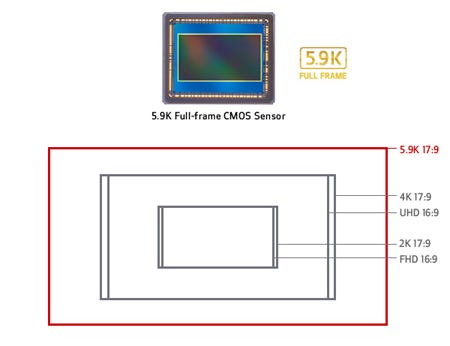
User interchangeable lens mounts and an available B4 mount adapter gives operators the freedom to make bold creative choices based on the subject matter.
The EOS C500 Mark II ships with an EF Mount that can be user swapped to an optional Locking EF (EF-C) or PL mount. Each mount swaps easily by simply removing four M3 hex screws.
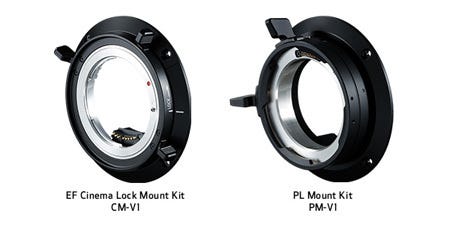
Thanks to the powerful DIGIC DV 7 image processing platform, the EOS C500 Mark II can record Cinema RAW Light directly to onboard CFexpress cards, which keeps the data-rich signal captured by the 5.9K full-frame sensor intact. Cinema RAW Light offers plenty of freedom for grading in file sizes that are about 1/3 to 1/5 the size of Cinema RAW.
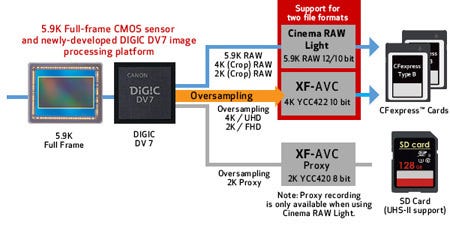
Canon has added three Cinema RAW Light recording modes, all with 12-bit recording capabilities, in addition to the existing RAW Light format, giving the camera four different RAW recording options to choose from. Download the firmware update to access these modes.
Cinema RAW Light HQ, ST, LT (as recorded on CFexpress card)
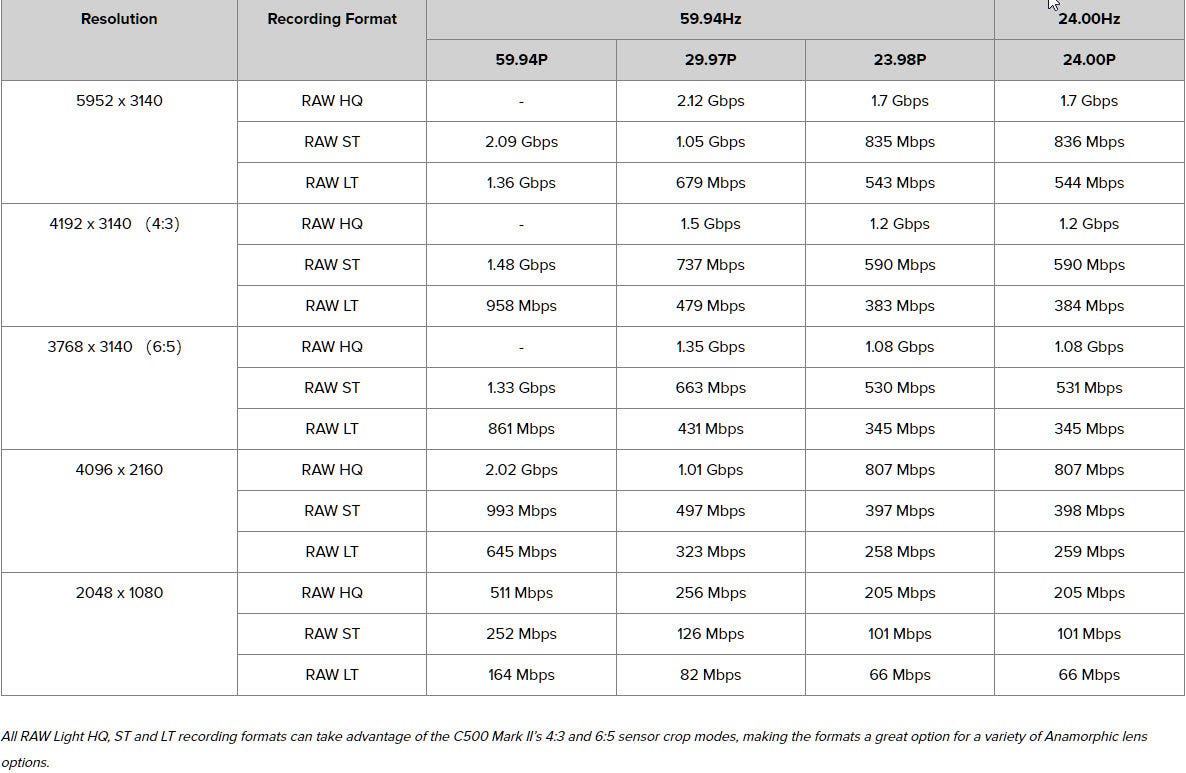
With Expansion Unit EU-V2, the EOS C500 Mark II supports up to 4-channel audio recording. Audio input from the camera’s internal microphone, mini mic port, and XLR ports can be assigned to the 4 different audio channels. This flexibility allows a wide range of audio devices to be connected and mixed directly on the camera.

The EOS C500 Mark II supports Canon Log 2 and Canon Log 3 Gamma. In post-production, Canon Log is designed to reproduce the entire tonal range that the CMOS image sensor is capable of. Log workflows provide the user with higher dynamic range, more highlight and shadow retention, and more flexibility in grading.Canon Log 2 provides the largest dynamic range and image detail. While Canon Log 2 provides the most post-production flexibility and full dynamic range of the sensor, it typically requires more time in color correction.
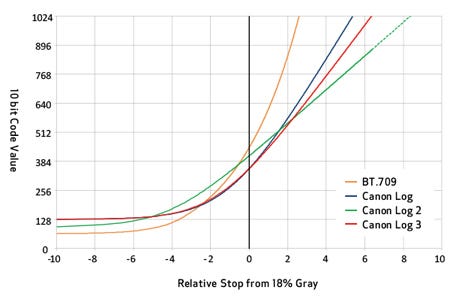
DAF can simulate a focus pull using preset locations. After setting two separate focus locations on screen, the cameras set button can be used to alternate between the two focus points. The focus racking effect can be fine-tuned by adjusting AF tracking speed and response.

The Cinema EOS C500 Mark II features Canon’s Dual Pixel CMOS AF Technology. For DAF, each pixel in the camera’s CMOS sensor is configured with two photodiodes. Two independent image signals can then be detected at each photosite and compared using phase-difference to provide autofocus with compatible lenses.
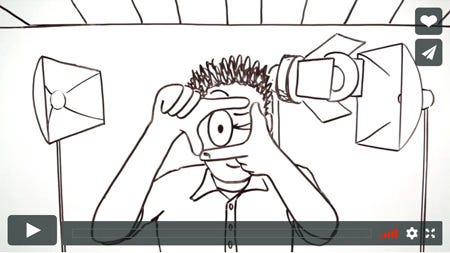
DAF can survey the scene and recognizes not only whether the subject is in focus or not, but in which direction (near or far), and by how much. DAF technology can also be used to aid in manual focus. Focus information is translated to an on-screen guide that conveys to the operator the subjects current focus and direction to move in order achieve focus. When sharp focus is achieved the indicator turns green as a clear indication.
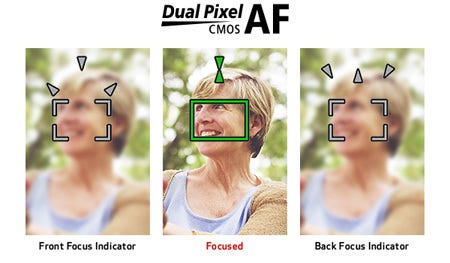
This unit converts the EOS C500 Mark II from a compact powerhouse to a full production camera system ready for anything. EU-V2 adds two additional XLR audio inputs, Lens port, 24-volt DC out, and D-Tap power, in addition to Genlock, sync out, Remote B (RS422) and Ethernet port. It also allows the camera to be powered using industry standard v-lock batteries.
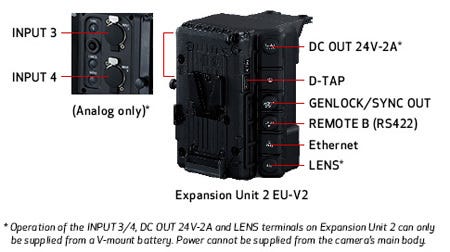
The EVF-V50 OLED electronic viewfinder is a tilting 0.46” approx. 1.77 million dot OLED EVF that offers outstanding visibility for single-operator applications, such as documentaries and outdoor interviews.
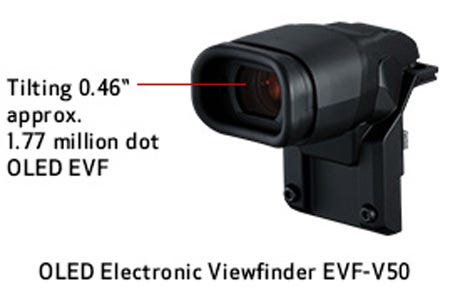
A new modular design allows productions to optimize and customize the EOS C500 Mark II to specific shooting needs. Accessories and expansion units can be easily attached to provide different levels of functionality. The camera is equally at home fully rigged with a large zoom lens, FIZ unit, audio accessories and rangefinder as it is stripped down flying on a drone.
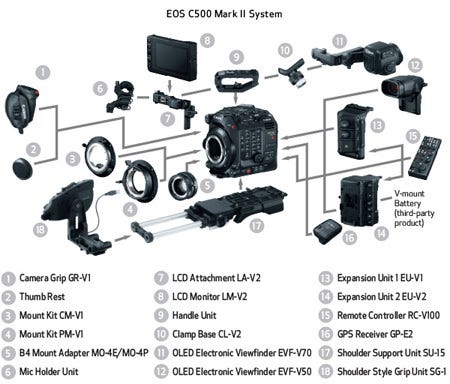
The EOS C500 Mark II offers cinematographers anamorphic lens support. Users can now achieve wide cinematic looks and oval bokeh particular to anamorphic glass. It is a distinctly cinematic palette that is within reach for your next project.
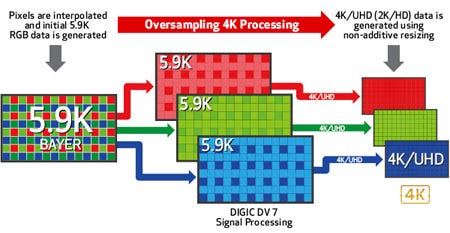
To accurately record the extensive data produced by the 5.9K imaging sensor and provide greater recording times, the EOS C500 Mark features two CFexpress recording slots. CFexpress is the future of onboard recording media providing write speeds needed for higher resolutions and frame rates. The dual card slots can be used to either create an instantaneous backup thorough simultaneous recording or extend record run times by relay recording.
